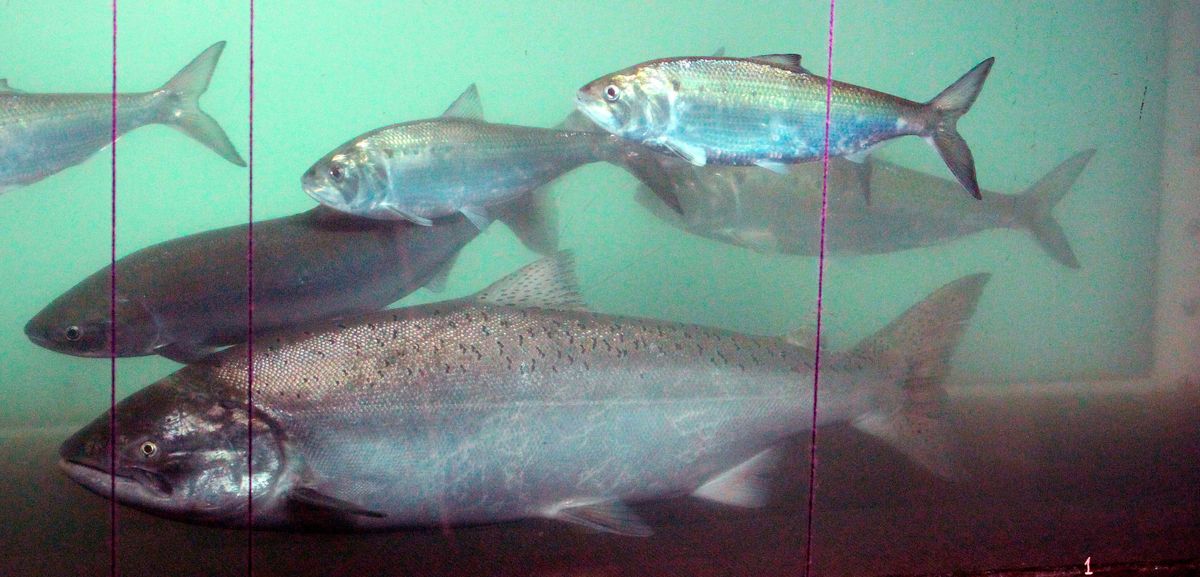Colville Tribes’ First Salmon ceremony illustrates power of salmon restoration

On May 23, the Colville Tribes celebrated salmon in a ceremony that dates back at least 13,000 years.
Randy Friedlander, Fish & Wildlife Director for the Colville Reservation, explained there is a rock at Kettle Falls, dated at over 13,000 years old, where native people from throughout the region would come for sharpening their stone knives.
“They called them ‘sharpener stones,’ ” he said. “We’ve fished here for a long time.”
Friedlander explained how salmon have nourished native people: “Our ancient obligation is that if we take care of salmon, they’ll take care of us.”
“The first salmon is symbolic. It’s offering itself up to us. We take part of it and everybody eats that spirit at the dinner,” he said. “We take a small piece of the salmon to honor the salmon. The remains of that salmon are put back into the river where it came from.”
The event was held at the Chief Joseph Hatchery across the Columbia River from Chief Joseph Dam. A tribal fisherman descended to river level and caught a salmon. Prayers were offered and ceremonial songs sung. The fish was killed, filleted and skinned, then skewered and placed over an open fire. Later, it was divided among those present.
While the fish cooked over the fire, several dozen people gathered in one of the hatchery buildings. Everyone was offered a piece of the “first salmon” during lunch.
Friedlander explained that after the dams were constructed, fish passage was virtually nonexistent into the upriver waters, and salmon all but disappeared in that area. “We had to send staff clear to Oregon to pick up a frozen salmon and bring it back here to perform the ceremony honoring salmon on the reservation.”
“This is a very exciting time along the river, with lots of opportunities,” said Cody Desautel, the tribe’s Natural Resource director. “Fish populations are increasing across the upper basin. We’re getting there! We’re starting to convince others that investments need to be made up here, and we’re also watching climate change.”
Casey Baldwin, a researcher for the tribe, spoke of new technology, one being the Whoosh system, which is a flexible tube which uses pressure to launch fish over dams or into lakes and rivers. Baldwin hopes to have salmon above the dams by this fall.
Baldwin pointed out the the effort involved other tribes, like the Coeur d’Alene and Spokane.
Angelo Vitale, fisheries manager for the Coeur d’Alene Tribe, explained the tribe’s ‘salmon in the classroom’ program. The first year, they got eggs from the Chief Joseph Hatchery and raised them in classroom tanks. With community support, those students released the salmon in Hangman Creek in 2018. It was the first time in more than 100 years that salmon had been in the upper Spokane River system.
Following up on that success, the tribe received 3,000 eggs from the U.S. Fish and Wildlife Service last fall.
Angelo reported about 95% survival from those eggs. On May 14, the Coeur d’Alene ribe released salmon in Hangman Creek. Some fish are being held over at the facility in Plummer for release next year.
“They will be 4 to 6 inches long at that time,” Angelo said. “We may look at releases of these larger fish farther down the Spokane River to try to evaluate passage through the dams.”
Casey Baldwin said that habitat assessment studies identified about 700 miles of potential chinook habitat and 1300 miles of steelhead habitat upstream of Chief Joseph Dam on this river system. “There’s lots of habitat up there.”
In 2016, the Spokane Tribe received a $100,000 grant from the Northwest Power and Conservation Council to study what can be done for salmon upstream from Grand Coulee. That work continues.
Friedlander added that the potential for large runs in the future are high.
And, in a final illustration of the efforts potential, he said, “We sampled 20 steelhead in this area last year. Genetic studies showed that of those 20, five were from above Grand Coulee. The dams block passage of fish, but the fish didn’t get the message. The Spokane Tribe puts those eggs in fish and they know they go down.
“Now we know they come back.”